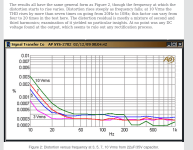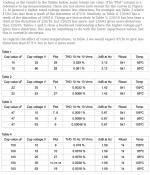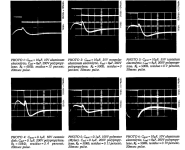there is a new preliminary work by Douglas Self :For hi-fi cathode bypass caps, we don't need but about 50 volts but we do need ~470uF-1,000uF. They are generally considered part of the signal path because they directly affect the signal, even though they are not directly in the signal path. I'm in the process of building my fourth and fifth point-to-point wired stereo tube amps. Axial or radial isn't an issue as far as fit because everything is point-to-point wired. Physical size isn't an issue, but cost always is.
Over the summer I used Nichicon UKA series for cathode bypass in a new Dynaco Stereo 35 build because they are "audio grade" per Nichicon, but they do not list ESR for them. Weird. https://www.mouser.com/datasheet/2/293/e_uka-3082349.pdf I parallelled them with some small value WIMA caps that I had on hand. Just wondering what the "best" two 2 or 3 actually are now. 146 pages into this thread, some discussed here have become the rare element known as unobtainium.
I have been using Rubycon LXW 450V 120uF for power supply caps parallelled with small value WIMA. https://www.mouser.com/datasheet/2/977/e_LXW-1600626.pdf
In conclusion, while the results are not as clear-cut as one might hope, there is a general result that if you are troubled by electrolytic capacitor distortion, you should use the highest voltage part you can. The results for the temperature rating are much less obvious, but nowadays I always use 105ºC parts for greater reliability (less drying out and reduction in value) over time. In the future I plan to test some non-polarized (NP) electrolytics; one might hope the results would be better.
Attachments
My suggestion is the bipolar Green Muse Nichicon ,very lo thd , Mundorf is a good ones too
Ps you can try polymer used in elekit and DC-link Kermet pp ,good price
Ps you can try polymer used in elekit and DC-link Kermet pp ,good price
Last edited:
Hi nicoch58,
Actually, the 105 ° capacitors sometimes perform worse than the 85 ° capacitors - measured in circuit and on their own. If the ambient temperature isn't high, they don't buy you one single thing. They use a different electrolyte, and it often does not perform as well. It is an excellent example of optimizing one characteristic at the expense of another. Yes, I listen and others do as well.
Film capacitors do not "burn in"... You do. Can you imagine the world of test and measurement (calibration, filter characteristics) if this were true? We send stuff into space, below the ocean where it is completely inaccessible. We do not burn stuff in for any longer than to confirm performance. Pilots fly, medical equipment runs keeping people alive or imaging their bodies. Can you imagine if capacitors changed a lot over time? Electrolytic types may have to reform, but once that is done, as long as they are not in service or hard service, they do not shift value that much. We size the parts to allow for that when we design stuff.
The actual truth is this. You become accustomed to the sound, not the other way around. Your audio memory is such that you couldn't notice a change like this if you were trained and tried. You can't. We do not have any internal reference and our memory is not fixed. Our emotional state affects us far more than the actual sound for small changes.
I get equipment in that is older. The client is happy with the sound even though it now fails spec. They adjusted and got used to the sound as it degraded over time. So when they get it back, every one of them comments they can't believe how good it sounds now, and all I did was return it to proper functioning status. So much for people being able to discern capacitors "breaking in", or any other component for that matter.
There is so much lore and claims made in audio that simple logic proves they are not true.
Actually, the 105 ° capacitors sometimes perform worse than the 85 ° capacitors - measured in circuit and on their own. If the ambient temperature isn't high, they don't buy you one single thing. They use a different electrolyte, and it often does not perform as well. It is an excellent example of optimizing one characteristic at the expense of another. Yes, I listen and others do as well.
Film capacitors do not "burn in"... You do. Can you imagine the world of test and measurement (calibration, filter characteristics) if this were true? We send stuff into space, below the ocean where it is completely inaccessible. We do not burn stuff in for any longer than to confirm performance. Pilots fly, medical equipment runs keeping people alive or imaging their bodies. Can you imagine if capacitors changed a lot over time? Electrolytic types may have to reform, but once that is done, as long as they are not in service or hard service, they do not shift value that much. We size the parts to allow for that when we design stuff.
The actual truth is this. You become accustomed to the sound, not the other way around. Your audio memory is such that you couldn't notice a change like this if you were trained and tried. You can't. We do not have any internal reference and our memory is not fixed. Our emotional state affects us far more than the actual sound for small changes.
I get equipment in that is older. The client is happy with the sound even though it now fails spec. They adjusted and got used to the sound as it degraded over time. So when they get it back, every one of them comments they can't believe how good it sounds now, and all I did was return it to proper functioning status. So much for people being able to discern capacitors "breaking in", or any other component for that matter.
There is so much lore and claims made in audio that simple logic proves they are not true.
On input/driver were 100uF, work really good Clartycaps TC or standard series ,motor run tooFor hi-fi cathode bypass caps, we don't need but about 50 volts but we do need ~470uF-1,000uF. They are generally
Please change the thread title to "Ecap De jure" 🙂
One thing that I do not understand is what the heck is wrong with stating the exact ecaps you are measuring, evaluating and use in your designs or service work? (Authors, are you worried about being sued? or what) Talk about beating about the bush.
In signal paths I prefer to use Nichicon UKL or UES, but have used UKA as well. Not to say that others would not work as well, it's just a preference, even though Nichicon is not the best supplier as far as availability goes.
I really do not get "ecap or any component breakin" either, esp when it comes down to using a ecap in the signal path. I understand stabalization, infant mortality, ecap leakage current specs etc. but ecap breakin as far as sound goes 🙂 What's the mechanism, were the ecaps that Doug Self measured "broken in"? 🙂
Do you not think if it is important enough the manufatures would make mention of these charateristics? esp when the ecaps are used for audio signal apps.
For a manufacturer, are you expected to wait out this ecap breakin period, under bias, before you test and qualify your product for sale to the customer?
My take on ecaps for audio 🙂
One thing that I do not understand is what the heck is wrong with stating the exact ecaps you are measuring, evaluating and use in your designs or service work? (Authors, are you worried about being sued? or what) Talk about beating about the bush.
In signal paths I prefer to use Nichicon UKL or UES, but have used UKA as well. Not to say that others would not work as well, it's just a preference, even though Nichicon is not the best supplier as far as availability goes.
I really do not get "ecap or any component breakin" either, esp when it comes down to using a ecap in the signal path. I understand stabalization, infant mortality, ecap leakage current specs etc. but ecap breakin as far as sound goes 🙂 What's the mechanism, were the ecaps that Doug Self measured "broken in"? 🙂
Do you not think if it is important enough the manufatures would make mention of these charateristics? esp when the ecaps are used for audio signal apps.
For a manufacturer, are you expected to wait out this ecap breakin period, under bias, before you test and qualify your product for sale to the customer?
My take on ecaps for audio 🙂
Last edited:
Hi nicoch58,
Do you know why they became popular to begin with? Someone decided you had to use polypropylene no matter what (not a bad choice) and these are less expensive that the proper industrial parts more suited. That is the reason you see moor run caps in use. Motor start caps are not suited at all.
This is basically audio fashion, if you understood how parts are made and how they work, you would know this.
And just how large are those capacitors? I know. The sheer size creates problems and motor run / AC mains applications force the design of those capacitors for factors other than what you would consider for audio.On input/driver were 100uF, work really good Clartycaps TC or standard series ,motor run too
Do you know why they became popular to begin with? Someone decided you had to use polypropylene no matter what (not a bad choice) and these are less expensive that the proper industrial parts more suited. That is the reason you see moor run caps in use. Motor start caps are not suited at all.
This is basically audio fashion, if you understood how parts are made and how they work, you would know this.
I don't think anyone decided that, its that PS and PC are simply much harder to find these days, PTFE are expensive, PP are cheaper and plentiful - they are all good dielectrics for through-hole caps.
For SMT, PS and PP aren't available as they melt during solder-reflow! PPS are perhaps the go-to dielectric for SMT.
For SMT, PS and PP aren't available as they melt during solder-reflow! PPS are perhaps the go-to dielectric for SMT.
In my experience 105c capacitors sound worse than 85c. To my surprise nobody else seems to notice this. Good for praise in reviews, bad for sound quality. They sound a bit closed in with a loss of timbre, I call it the new modern sound 🙁.Actually, the 105 ° capacitors sometimes perform worse than the 85 ° capacitors - measured in circuit and on their own. If the ambient temperature isn't high, they don't buy you one single thing. They use a different electrolyte, and it often does not perform as well. It is an excellent example of optimizing one characteristic at the expense of another. Yes, I listen and others do as well.
not all my Siemens Sikorel 125° still sound good...In my experience 105c capacitors sound worse than 85c. To my surprise nobody else seems to notice this. Good for praise in reviews, bad for sound quality. They sound a bit closed in with a loss of timbre, I call it the new modern sound 🙁.
In my experience 105c capacitors sound worse than 85c.
They often show this in measured characteristics.
Which measurements to look at for tube cathode resistor bypass (usually electrolytic, ~470uF-1000uF @ 35-50V)?
Which measurements to look at for tube power supply (electrolytic, ~100uF-330uF @ 450V or higher)
So I should be using Nichicon UKL in 85C vs 105C, since they come in both. I wonder if the datasheet identifies differences, like materials etc.In my experience 105c capacitors sound worse than 85c.
try both and report here 😉 diy's need thissince they come in both
Nichicon Muse FG or Elna Silmic 2 if you can find them. Both are out of production now, but some shops still have them in stock.
Look at the tahn value Rick. Not catalogue, measured at 1 KHz.
Report by listening? How about measuring the performance and listening, then report. There may or may not be a difference, but over the years I have seen that you can't trust that 125 ° types are better and I have used / listened to / measured both types. The differences were backed up by component measurements.
Report by listening? How about measuring the performance and listening, then report. There may or may not be a difference, but over the years I have seen that you can't trust that 125 ° types are better and I have used / listened to / measured both types. The differences were backed up by component measurements.
Actually, they do, implicitly.In my experience 105c capacitors sound worse than 85c. To my surprise nobody else seems to notice this....
Most of the "known good" 'lytics, Silmic, Muse, and so forth, are 85°C.
AFAIK, Nichicon has a bunch of "for audio" caps, and only a very few of them are 105°.
Capacitor behaviour under certain conditions does not translate into audio performance. To make any sense, you have to post the exact circuit conditions, schematic and test procedure (along with test equipment used). Then all that has to have a bearing on the use in audio the capacitor will actually see.
Another aspect is capacitor size. Sure, some types can be a touch better in an application, but the "better" part may be 5x the size (or even bigger) than the next best part. That in itself can create additional problems - practical ones. Therein lies the danger of looking at some aspects of a part without looking at the big picture. It all matters. I haven't even looked at the costs involved in making extreme part selections while ignoring practical aspects.
I just yanked a bunch of capacitors a customer paid about $70 each for. They were too large for the application and caused issues right there. Sadly the sub $10 parts I used were actually better - and they fit! Overall performance improved in a measurable way and the customer reported back he could hear the difference, which was better. In fairness I fixed a bunch of issues that the previous "tech" had caused as well. These were very expensive tube monoblocks universally acknowledged for high performance.
Part selection is an aspect of engineering. Knowing the parts, and knowing the application as well as understanding physical layout of circuits. That is when you get it right, anything else is chance. Face it, some things simply do not matter - like metallic tubes covering capacitors and stupid stuff like that. Same for some separators between capacitor plates. That stuff should be inert (what does that means folks?). A little common sense and understanding could really clean up the industry and save millions of wasted dollars.
Fairy tails are for children.
Another aspect is capacitor size. Sure, some types can be a touch better in an application, but the "better" part may be 5x the size (or even bigger) than the next best part. That in itself can create additional problems - practical ones. Therein lies the danger of looking at some aspects of a part without looking at the big picture. It all matters. I haven't even looked at the costs involved in making extreme part selections while ignoring practical aspects.
I just yanked a bunch of capacitors a customer paid about $70 each for. They were too large for the application and caused issues right there. Sadly the sub $10 parts I used were actually better - and they fit! Overall performance improved in a measurable way and the customer reported back he could hear the difference, which was better. In fairness I fixed a bunch of issues that the previous "tech" had caused as well. These were very expensive tube monoblocks universally acknowledged for high performance.
Part selection is an aspect of engineering. Knowing the parts, and knowing the application as well as understanding physical layout of circuits. That is when you get it right, anything else is chance. Face it, some things simply do not matter - like metallic tubes covering capacitors and stupid stuff like that. Same for some separators between capacitor plates. That stuff should be inert (what does that means folks?). A little common sense and understanding could really clean up the industry and save millions of wasted dollars.
Fairy tails are for children.
- Home
- Design & Build
- Parts
- Best electrolytic capacitors


